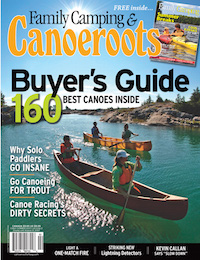Thirty kilometres as the crow flies from my front porch is a blue hardcover notebook on a worn pine kitchen table, in the middle of a mossy log cabin overlooking a small lake. On the first page of the notebook it reads: “Welcome to our fishing camp. You may use our camp and you are welcome here. Please leave the camp as it was and treat it like it’s yours. Please leave your name, the date and how your fishing went. Good luck fishing! P.S. The toilet paper is in the fridge.”
The lake is well known in my area for its speckled trout. For two summers my neighbour Bobby and I have been planning a trip in to try our luck.
I’m more of a hump-my-gear-through-the-woods canoe- ist and Bobby is more of a tow-his-motorboat-to-the-lake fisherman, but our sense of adventure and our craving for speckles (not to mention his beer fridge) brought us together in his workshop on winter nights to dream about our fishing trip.
Finally, on the last Saturday of trout season we loaded Jellybean—an old, heavy and stable fibreglass square- stern canoe—and a borrowed electric trolling motor onto Bobby’s Yamaha Rhino ATV. In a cloud of dust I’ve never before kicked up on a portage, we tore off in the direction of the lake.
The ride to our trout lake is much further by logging road, snowmobile route and bouldery four-wheeler trail than it is for the straight-flying crow. A journal entry in the cabin’s notebook describes the trip quite well, “Broke one beer on the way. Shook the shit out of the rest.”
Finding our way back to the lake turned out to be as much fun as the fishing. With the help of a topographic map, GPS and directions sketched on the back of a Coors Light label we rolled up to the cabin around noon. Bobby bagged two partridge on the way (we had a shotgun along in case the fish weren’t biting). Once we found the lake, it wasn’t long before we had Jellybean in eight feet of water and we were marking trout on our sonar.
In our district, it is Darwin Rosien’s job to release 16- month-old trout in 123 lakes as part of the Ontario Min- istry of Natural Resources’ fish-stocking program. In early May, when the water temperature is just right, Darwin bajas into the lakes he can in a five-ton truck balancing a highly specialized fish bowl on the back. Some lakes, like ours, are just too remote to get to by truck so the lucky fingerlings are chauffeured by helicopter to their new homes.
Lakes that are too inaccessible to stock by truck are often too far away to portage a canoe or too remote to tow a fishing boat into. These are just the kind of fishing destinations perfect for old Jellybean, Bobby and me.
DECORATED BY THREE GENERATIONS OF MEN’S MEN
With enough speckles for dinner, Bobby loaded our gear back into the Rhino and I wandered up to explore the little log cabin. There are hundreds of these rustic fish and hunt camps on Crown land and many you’ll find—if you find them at all—are left unlocked and well-stocked, like the lakes they’re built on.
This cabin is a tidy two-room affair, furnished and decorated by no less than three generations of men’s men.
The liquor cabinet is a rusty and dented breadbox, stocked with an uncracked bottle of Crown Royal and a six-pack of Bud in cans with two empty rings.
Old fishing rods and broken cross-cut saws hang on the walls and a transistor radio on the windowsill is tuned to the local country music station. In the cupboards there are bags of potato chips, cans of coffee, whitener, sugar, decks of cards and two cribbage boards with toothpicks for pegs.
In the kitchen, 10 frying pans—yes 10—hang on the wall. And above the propane stove rests a box of Red Bird matches and the largest roll of aluminum foil I’ve ever seen. This is the type of kitchen where fresh fish is always on the menu.
There was a battery in the deer clock. Tick. Tick. Tick. It was 4:30. Meaghen, Miss June 2004, watched me sit down at the kitchen table and log our trip in the notebook:
September 23, 2006. Scott and Bobby were here. They were really biting well; we kept four nice ones. I write for a canoeing magazine and I’m going to write about our ATV trip into your camp. I’ll bring a couple of copies when we come back in the spring. It’s gracious of you to leave your camp open for others to enjoy.
P.S. Don’t worry. I won’t mention where it is.
Scott MacGregor is the publisher of Canoeroots & Family Camping. Look for his latest project, Kayak Angler magazine, in fishing and paddling shops. and in case you’re wondering, the toilet paper is kept in the fridge so the mice can’t get at it.




